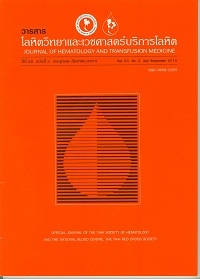การศึกษาหาปริมาณโลหิตสำรองที่เหมาะสมของโรงพยาบาลตำรวจ
Keywords:
Blood inventory control, Blood inventory levelsAbstract
บทคัดย่อ
ความเป็นมาและปัญหา : โรงพยาบาลตำรวจเป็นโรงพยาบาลระดับ 600 เตียง มีปริมาณการใช้เม็ดโลหิตแดงเฉลี่ยจำนวน 650 ยูนิตต่อเดือน เป้าหมายของการบริหารโลหิตสำรองที่มีประสิทธิภาพมุ่งเน้นการจัดหาโลหิตสำรองที่ปลอดภัยและเพียงพอต่อความต้องการใช้ของผู้ป่วย โดยมีปริมาณโลหิตหมดอายุจำนวนน้อย การทบทวนการใช้โลหิตเพื่อหาปริมาณโลหิตสำรองที่เหมาะสมนั้นจำเป็นมาก เพื่อใช้เป็นข้อมูลในการกำหนดแผนการจัดหาโลหิตสำรองสำหรับภาวะฉุกเฉิน และเป็นการพัฒนาการใช้โลหิตอย่างเหมาะสมด้วย วิธีการ : ศึกษาโดยรวบรวมข้อมูลการใช้โลหิตของผู้ป่วยในโรงพยาบาลตำรวจย้อนหลัง 6 เดือน ระหว่างวันที่ 1 มกราคม-30 มิถุนายน 2551 คำนวณหาปริมาณโลหิตสำรองเฉลี่ยโดยใช้วิธีคำนวณต่อวัน และต่อสัปดาห์ เพื่อหาปริมาณโลหิตสำรองที่เหมาะสมโดยจำแนกตามชนิดส่วนประกอบของโลหิตและหมู่โลหิต ABO และบวกเพิ่มอีกสิบเปอร์เซ็นต์ในแต่ละชนิดของส่วนประกอบโลหิตเพื่อรองรับสถานการณ์ฉุกเฉิน ผลการวิจัย : จากการศึกษาพบว่ามีการใช้เม็ดโลหิตแดง จำนวน 3,995 ยูนิต พลาสมาสดแช่แข็ง จำนวน 1,883 ยูนิต ไครโอปรีซิปิเตท จำนวน 900 ยูนิต และมีการใช้เม็ดโลหิตแดงหมู่ Rh negative เพียง 7 ยูนิต การคำนวณหาปริมาณเม็ดโลหิตแดงสำรองที่เหมาะสม จากวิธีคำนวณปริมาณโลหิตสำรองเฉลี่ยต่อวัน จำแนกตามหมู่โลหิต O, A, B และ AB ได้เท่ากับ 62, 39, 54 และ 15 ยูนิต ซึ่งไม่แตกต่างกันอย่างมีนัยสำคัญทางสถิติจากวิธีคำนวณหาปริมาณโลหิตสำรองเฉลี่ยต่อสัปดาห์ เท่ากับ 62, 36, 53 และ 12 ยูนิต ตามลำดับ (p > 0.05) ปริมาณสำรองพลาสมาสดแช่แข็งที่เหมาะสมจากการคำนวณการใช้ต่อวัน เท่ากับ 31, 23, 23 และ 8 ยูนิต การคำนวณต่อสัปดาห์ เท่ากับ 27, 19, 24 และ 5 ยูนิต ตามลำดับ การสำรองไครโอปรีซิปริเตทที่เหมาะสมคำนวณการใช้สูงสุดต่อวัน และต่อสัปดาห์ เท่ากับ 60 และ 168 ยูนิต ตามลำดับ สรุป : การศึกษาครั้งนี้ทำให้ทราบปริมาณโลหิตสำรองที่เหมาะสมของโรงพยาบาลตำรวจ จากข้อมูลที่ได้สามารถนำไปใช้พัฒนาการสำรองโลหิต เพื่อให้มีปริมาณโลหิตสำรองเพียงพอและสม่ำเสมอ ทั้งในภาวะขาดแคลนโลหิตและภาวะที่มีปริมาณโลหิตมากเกินความจำเป็น อย่างไรก็ตามควรมีการศึกษาทบทวนการใช้โลหิตเป็นระยะ เพื่อปรับเปลี่ยนปริมาณโลหิตสำรองให้เหมาะสมตามสถานการณ์ที่เปลี่ยนไป
Key Words : Blood inventory control, Blood inventory levels
Abstract
Background : At present time, the demand of blood usage for therapeutic purpose is increased. Average transfusion of blood usage of Police General Hospital is about 650 units of red blood cells for each month. The goal of efficient blood inventory management must be providing the safe and adequate blood to meet the demand with minimum wastage. A review of blood usage is necessary to meet an optimal inventory levels. This result will be proposed to set an emergency blood stock management and improve in appropriate blood utilization. Methods : A retrospective study of blood usage was studied at Police General Hospital during 6 month period, from January–June 2008. Each blood component was calculate by estimation of average daily, weekly blood usage and optimal inventory levels of each ABO group and Rh type. Determine the minimum inventory level by multiplying the average by the number of days of blood supply required to be on hand (7 days). Addition ten percents of each blood component was calculated to cover emergency need. Results : Three thousand nine hundred ninty-five units of red blood cells (RBC), 1,883 units of fresh frozen plasma (FFP), 900 units of cryoprecipitate (CPP) and 7 units of Rh negative RBC were transfused during the study period. The optimal inventory level of RBC was calculated from average daily usage of group O, A, B and AB were 62, 39, 54 and 15 units respectively, no statistically difference to average weekly usage were 62, 36, 53 and 12 units respectively (p > 0.05). The optimal inventory level of FFP was calculated from average daily usage of group O, A, B and AB were 31, 23, 23 and 8 units respectively; average weekly usage were 27, 19, 24 and 5 units respectively. The highest daily and weekly use of cryoprecipitate was 60 and 168 units respectively. Conclusions : The optimal inventory levels obtained from this study was used as a guide to arrange and maintain continuous blood supply in both shortage and surplus situations in Police General Hospital. However, this optimal inventory levels should be evaluated periodically and when the situation changes.
Key Words : Blood inventory control, Blood inventory levels



